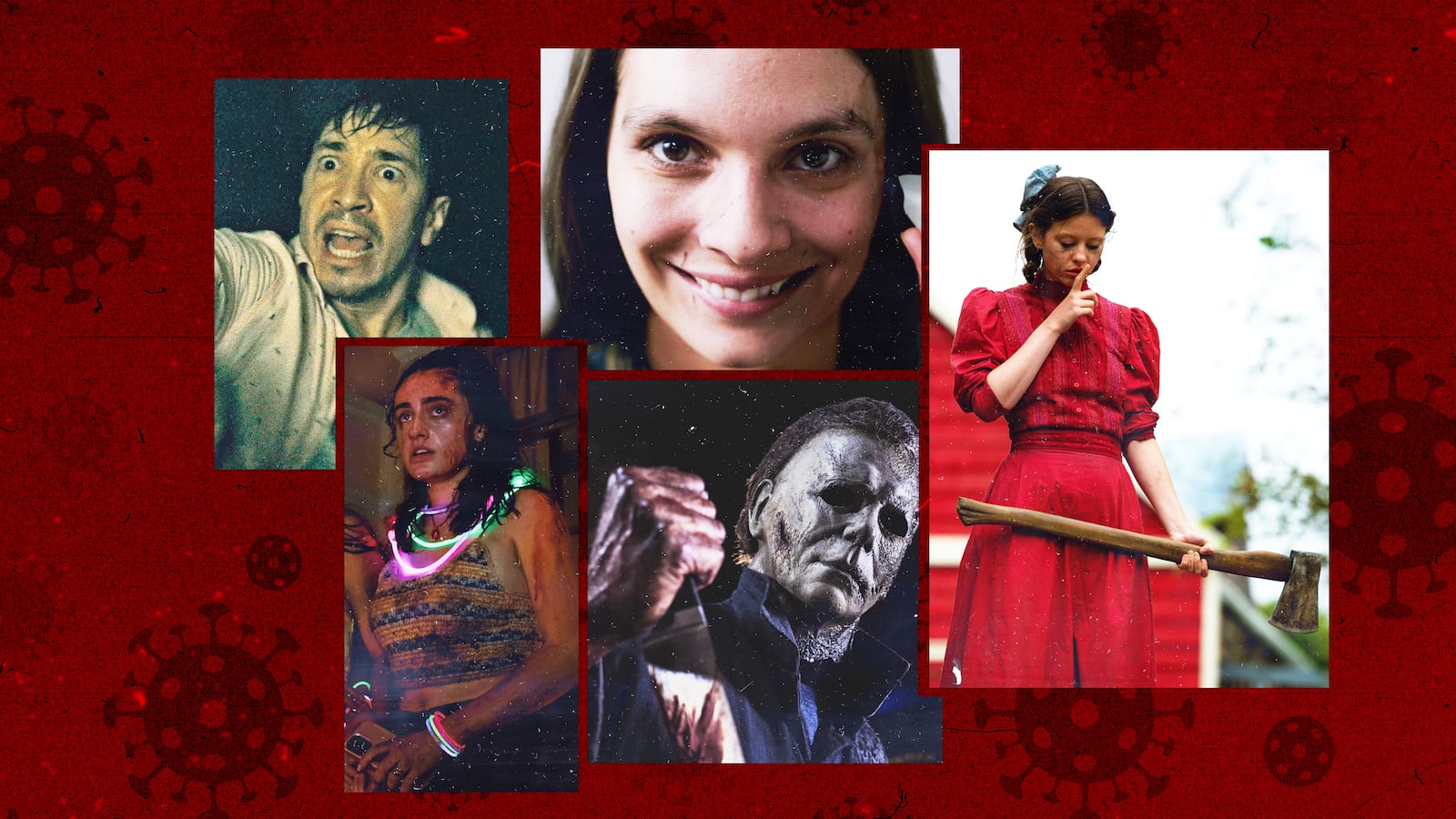Since the beginning of the pandemic in March 2020, Hollywood has struggled to adjust to our harrowing new reality. Delayed releases, shelved projects, shifting business models, massive company layoffs, and a slew of industry-wide scandals have left the entertainment world in a creative and economic limbo. However, one arguably good thing to come out of Tinseltown during this still ongoing health crisis is the influx of critically and commercially successful horror films.
This year alone has seen the emergence of some extremely profitable and original horror storytelling. Zach Cregger’s twisted domestic thriller Barbarian became a sleeper hit through strong word-of-mouth, earning $42 million worldwide on a $4 million budget. Scott Derrickson’s child abduction/paranormal mashup The Black Phone made a whopping $161 million at the global box office with a $16 million budget. Halina Reijn’s Gen-Z slasher Bodies Bodies Bodies raked in a healthy $13.6 million during a barren August weekend.
Jordan Peele’s cowboys-vs-aliens horror pic Nope received the best original film opening since his 2019 film Us. Parker Finn’s jumpscare-heavy Smile grossed $167 million on a $17 million budget, with the help of an effective marketing campaign, beating out Billy Eichner and Nicholas Stoller’s hotly anticipated rom-com Bros for the #1 spot. Even Terrifier 2, the sequel to Damien Leone’s 2016 splatter slasher, managed to churn out $5.4 million against a Kickstarter-backed $250,000 budget.
The physical restrictions of the pandemic also created greater opportunities for horror writer-directors looking to make good use of quarantine-induced isolation, especially in capturing our tetheredness to technology.
Filmmaker Rob Savage, for instance, developed the supernatural cyber-thriller Host in 2020 from a viral prank skit, using Zoom as a clever narrative device to explore anxieties around social separation and our culture’s increasing loss of connection. Jane Schoenbraun’s unsettling Sundance flick We’re All Going to the World’s Fair similarly delved into social alienation through the dark corners of Skype and YouTube, employing a small-scale, atmospheric approach to reflect contemporary fears around vulnerability in virtual spaces.
Horror seized its largest share of the box office in history in 2020, nearly double than normal, then broke its own record in 2021, proving that its hot streak was no fluke. It can be argued that the genre’s financial prosperity stems mainly from the fact that horror movies can be made very cheaply.
But it’s also possible that their increasing popularity within the zeitgeist speaks to how we’ve faced and endured so much horror in our lives on such a massive scale. The pandemic has damaged the infrastructure of the American health-care system, stoked political divisions, and created more suffocating conditions for essential workers. Horror films, in turn, seem to provide a kind of catharsis in the wake of psychological burnout and cultural trauma from the pandemic, in a way that other genre movies can’t.
A recent study from Science Direct supports this idea, suggesting that horror fans and morbidly curious audiences exhibit more resilience and less psychological distress during COVID-19.
“One reason that horror movies are so popular right now is that the world is going through, and has been going through the last couple years, a lot of drastic changes and scary things,” Coltan Scrivner, the research scientist behind this study, says. “Whether you're scared of COVID itself or the lockdowns or job security or any other number of scary situations that kind of come along with a global pandemic, there’s a lot of fear in the world. When people are feeling afraid, there’s a good portion of people who seek out scary fictions to kind of work through some of those feelings.”
Scrivner points to movies like Steven Soderbergh’s 2011 pandemic thriller Contagion, which experienced a viewership resurgence back in 2020, as an example of a horror story that has symbolically helped us work through not only our fears of infectious agents, but also our responses to them.
“It sucks to be afraid of something with real consequences,” Scrivner continues. “It doesn’t feel good to feel afraid or anxious about something in the real world and we typically try to avoid those feelings. But when you can feel afraid or feel anxious about something fictional, or something in entertainment and media, you have a little more control over the source of that anxiety or that fear.”
According to Scrivner, that control can look like a few things. When watching a horror movie at home, particularly, it could be dialing down the volume, keeping the lights on, viewing the film with a friend, or looking up spoilers beforehand. By manipulating our environment and our consumption of horror media, Scrivner observes, we can turn down our real-life worries. Our bodies subsequently go through a kind of physiological reset after exposure to frightening fictional simulations. There may not be a clear temporal endpoint to the pandemic, but there is one for a scary film, TV show, or haunted house attraction.
What’s also helpful is finding humor and absurdity in these films, which the recent uptick of horror movies have seemed to embrace. Think of Justin Long’s unexpected dark comic relief in Barbarian, the B-movie camp of M. Night Shyamalan’s existential horror blockbuster Old, or the deeply unhinged twist in James Wan’s batshit Malignant.
Most notably, actress Mia Goth, who stars in Ti West’s exploitation pastiche X, its Spanish flu-set prequel Pearl, and the upcoming sequel MAXXXINE, has emerged as somewhat of a contemporary horror comedy icon. Critics and audiences alike have praised Goth’s hammy turn as the hapless aspiring performer Pearl, with several of her lines of dialogue—“Please, I’m a staaaaaar!,” “I’m MARRIED!” and “…You’re lying”—becoming widely circulated Twitter memes.
The upcoming James Wan-produced M3GAN has already made waves when its trailer dropped a few weeks ago, with its titular Chucky-meets-Terminator star transforming into an immediate online sensation.
The common intersection between horror and comedy isn’t a mere coincidence. In fact, there seems to be a primal correlation between the two genres.
“I think horror and comedy are the most closely related genres because both of them deal with these benign violations,” Scrivner notes. “Comedy deals with benign moral violations and horror deals with benign threats or benign dangerous violations. Both of those allow us to kind of play with concepts that are a little taboo or a little frightening and threatening.”
Taking something scary and turning it into something funny can help us cope with our extended, drawn-out dread, a type of exposure therapy.
Along with comedic horror, body horror films have also popped up quite a bit during the pandemic, namely Julia Ducoranau’s Palme d’Or-winning Titane, Mimi Cave’s Fresh, Brandon Cronenberg’s Possessor, and his father David’s much-anticipated cinematic comeback Crimes of the Future.
The critical acclaim these films reaped didn’t necessarily translate into the most lucrative dividends (with the exception of Fresh, which was released directly to streaming on Hulu). However, their thematic deconstructions of the corporeal form do seem to signal a growing interest in narrativizing our culture’s changing relationship to the body, particularly when it comes to gender, age, and autonomy. In a world where trans and reproductive rights are continually threatened by the government, the politics of body horror may only grow more trenchant over time, for better or worse.
As a morbidly curious person who has dealt with COVID, GI issues, a gender crisis, and a few loss-related traumas during the pandemic, I find my tolerance for horror only getting stronger. Even though I’ll still sometimes read the Wikipedia synopsis and hover my hands over my eyes during suspenseful moments, I have come to embrace watching scary movies because of their emotional, intellectual, and visceral benefits. There is something immensely satisfying about watching something that will spook, haunt, or rattle me, knowing that it isn’t real, and being able to experience and discuss it among a community of equally thrill-seeking spectators.
It may take a while for Hollywood and the rest of the world to completely recover from the pandemic’s unpredictability. For now, though, we can at least count on horror storytelling to guide us through it.






